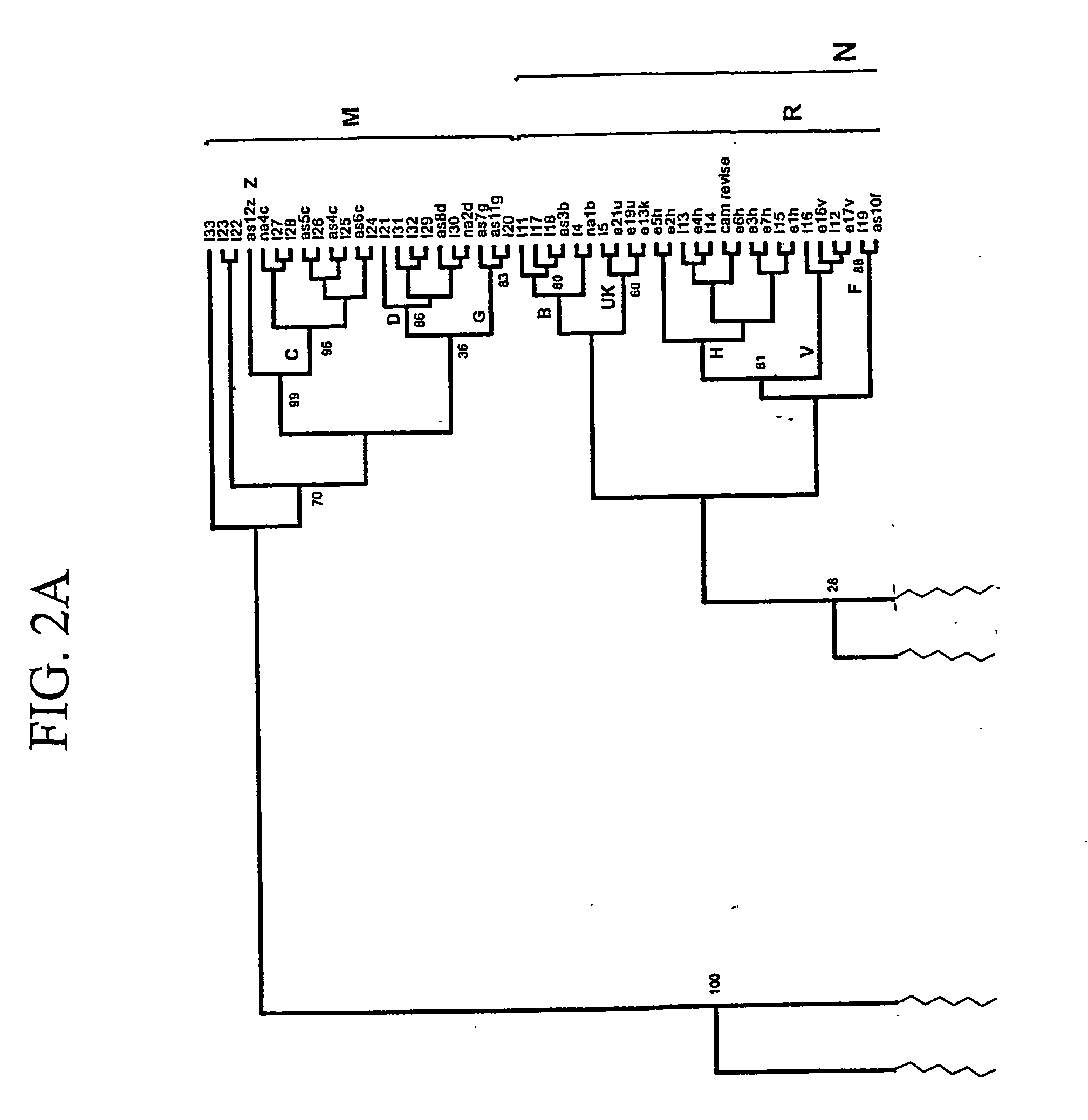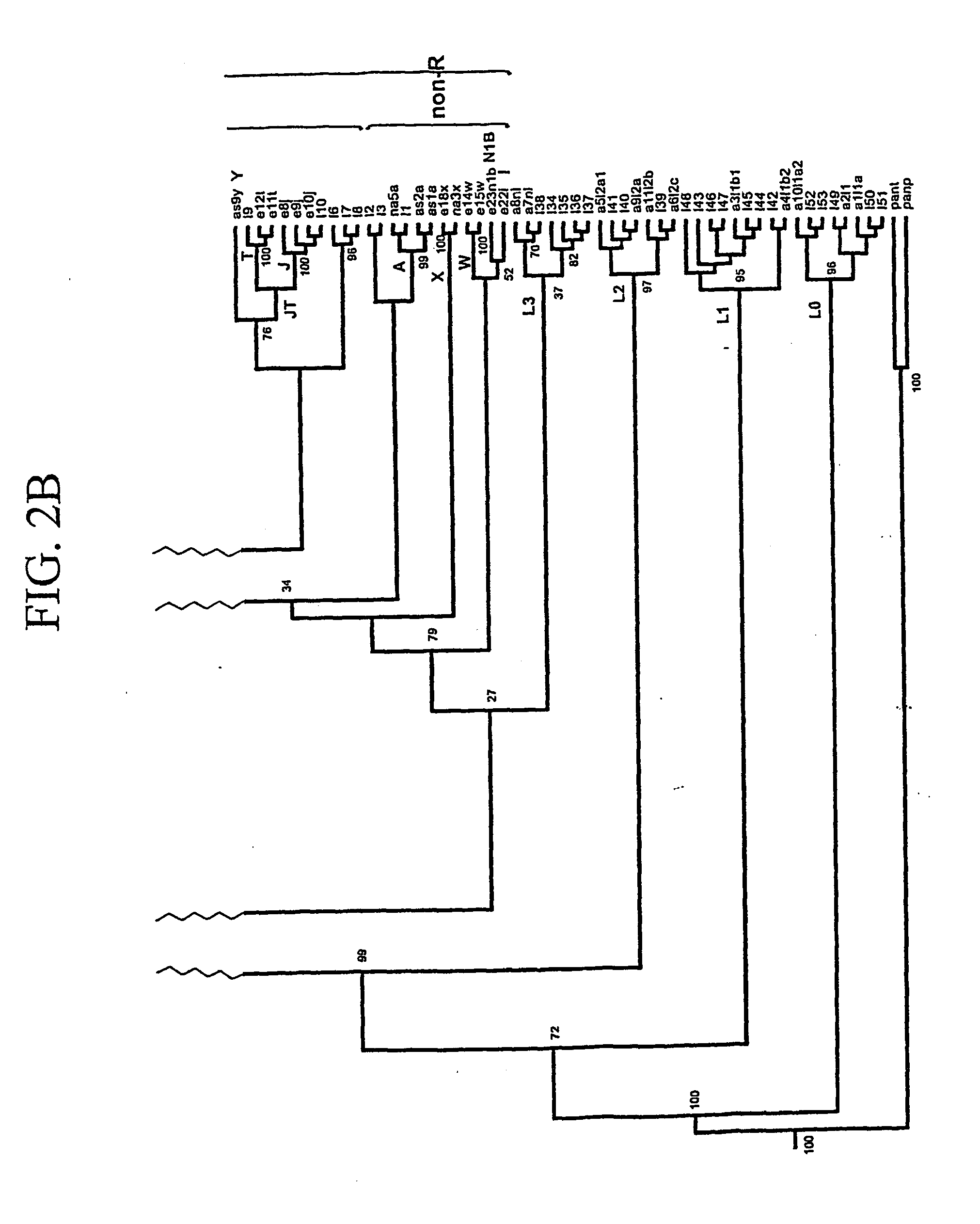Human mitochondrial dna polymorphisms, haplogroups, associations with physiological conditions, and genotyping arrays
a technology haplogroups, applied in the field of human mitochondrial dna polymorphisms, haplogroups, associations with physiological conditions, and genotyping arrays, can solve the problem that none of these methods are used to analyze a datas
- Summary
- Abstract
- Description
- Claims
- Application Information
AI Technical Summary
Problems solved by technology
Method used
Image
Examples
example 1
[0100] This invention provides human mtDNA polymorphisms found in all the major human haplogroups. Table 3 shows naturally occurring nucleotide alleles identified in the complete mtDNA sequences of 103 individuals, as compared to the mtDNA Cambridge sequence. All nucleotide sequences not listed are identical to the Cambridge sequence. Nucleotide alleles previously known to be associated with disease conditions, such as those listed in Table 1, are not listed in Table 3. Some deletion or rearrangement polymorphisms have also been excluded. All polymorphisms listed are nucleotide substitutions except for a nine-adenine nucleotide deletion at positions 8271-8279.
TABLE 3Human MtDNA Nucleotide Allelesnon-nucleotideCambridgeCambridgelocusallelesalleles64CT72TC73AG89TC93AG95AC114CT143GA146TC150CT151CT152TC153AG171GA180TC182CT183AG185GA185GT186CA189AC189AG194CT195TA195TC198CT199TC200AG204TC207GA208TC210AG212TC215AG217TC225GA227AG228GA235AG236TC247GA250TC252TC263AG291AG295CT297AG316GA317CA...
example 2
[0102] The mtDNA sequences of Example 1 were chosen because they represent all of the major haplogroup lineages in humans. Analysis of these sequences has reaffirmed that all human mtDNAs belong to a single maternal tree, rooted in Africa (R. L. Cann et al., Nature 325:31-36 (1987); M. J. Johnson et al., (1983) Journal of Molecular Evolution 19:255-271; D. C. Wallace et al., “Global Mitochondrial DNA Variation and the Origin of Native Americans” in The Origin of Humankind, M. Aloisi, B. Battaglia, E. Carafoli, G. A. Danieli, Eds., Venice (IOS Press, 2000); M. Ingman et al., (2000) Nature 408:708-13; and D. C. Wallace et al., (1999) Gene 238:211-230). A cladogram of these mtDNA sequences is shown in FIG. 1. Haplogroups are designated on branches of the tree. A calibration of the sequence evolution rate for the coding regions of the mtDNA, based on a human-chimpanzee divergence time of 6.5 million years ago (MYA) (M. Goodman et al., (1998)Mol Phylogenet. Evol. 9:585-98), has permitted...
example 3
Inter-Continental Founder Events
[0103] The most striking feature of the mtDNA tree is the remarkable reduction in the number of mtDNA lineages that are associated with the transition from one continent to another. For example, when humans moved to Eurasia from Africa, the number of mitochondrial lineages was reduced from dozens to two lineages. While northeastern Africa encompasses the entire range of African mtDNA variation from the exclusively African haplogroups L0-L2 to the progenitors of the European and Asian mtDNA lineages, only two African mtDNA lineages, macro-haplogroups M and N, which arose about 65,000 YBP, left Africa to colonize Eurasia. Moreover, the times of the MRCAs of macro-haplogroups M and N as well as sub-macro-haplogroup R are similar, suggesting rapid population expansion associated with the colonization of Eurasia.
[0104] Similarly, when humans later moved from Central Asia to the Americas, the number of lineages was again reduced from dozens to about five...
PUM
| Property | Measurement | Unit |
|---|---|---|
| length | aaaaa | aaaaa |
| nucleic acid sequences | aaaaa | aaaaa |
| temperature | aaaaa | aaaaa |
Abstract
Description
Claims
Application Information
 Login to View More
Login to View More - R&D
- Intellectual Property
- Life Sciences
- Materials
- Tech Scout
- Unparalleled Data Quality
- Higher Quality Content
- 60% Fewer Hallucinations
Browse by: Latest US Patents, China's latest patents, Technical Efficacy Thesaurus, Application Domain, Technology Topic, Popular Technical Reports.
© 2025 PatSnap. All rights reserved.Legal|Privacy policy|Modern Slavery Act Transparency Statement|Sitemap|About US| Contact US: help@patsnap.com



